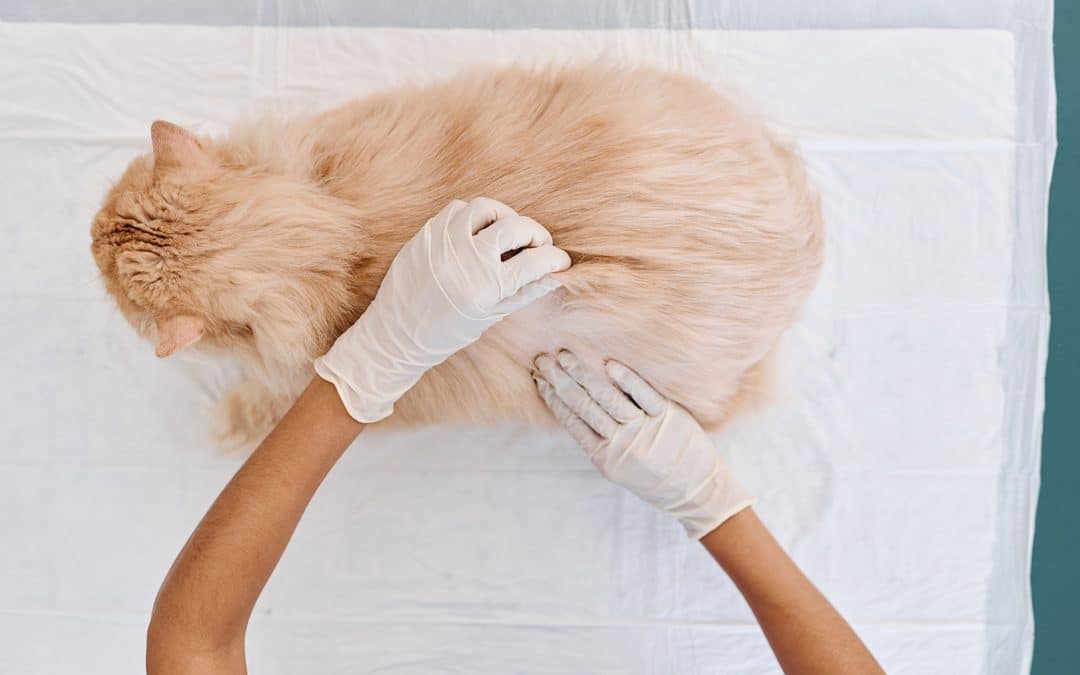Skin diseases are not uncommon in dogs and cats. In fact, they affect pets of all ages and breeds. Whether it’s an itchy rash, hair loss, or something more severe, many pets will experience a skin issue at some point in their lives. Skin conditions can be uncomfortable painful, and can sometimes indicate underlying systemic issues. Identifying and addressing these problems promptly can improve your pet’s quality of life and prevent more serious complications down the road.
Common Skin Diseases that Affect Pets
Common Skin Diseases in Dogs
- Flea Allergy Dermatitis: Flea allergies are a common issue among dogs. These tiny parasites can cause severe itching, redness, and skin irritation in sensitive individuals. Recognizing and treating flea infestations promptly is crucial to preventing this condition.
- Atopic Dermatitis: Often referred to as Atopy, atopic dermatitis is characterized by itchy and inflamed skin and can often have a secondary infection. Atopy is a complicated condition that can result from allergies to environmental factors like pollen, dust mites, or certain foods. This is often a lifelong condition but will flare up depending on the season or environmental triggers.
- Hot Spots (Acute Moist Dermatitis): Hot spots are painful, moist, and red skin lesions often resulting from self-inflicted trauma due to itching or scratching. They can quickly worsen if not addressed.
- Mites: Common types of mites can include demodex or sarcoptic mange, also known as scabies. Mites are microscopic and require veterinary testing to diagnose. Mite infestation leads to intense itching, hair loss, and skin inflammation. Prompt veterinary intervention is necessary to manage this potentially contagious condition.
- Bacterial and yeast Infections: Dogs are susceptible to bacterial and yeast infections, which can occur secondary to other skin conditions or injuries. These infections often manifest as pustules, sores, or crusty lesions.
- Fungal Infections (Ringworm): Despite its name, ringworm is not caused by a worm but by a fungus. It usually leads to the classic circular, bald patches on the skin but can appear different on different species, such as cats. Ringworm is highly contagious to both other animals and humans.
- Skin Cancer: Dogs are susceptible to various forms of skin cancer, both benign and malignant. Early detection and treatment are crucial for managing a potentially serious condition.
Common Skin Diseases in Cats
- Flea Allergy Dermatitis: Cats are not immune to flea allergies either. Flea bites can cause severe itching and discomfort, leading to excessive scratching and hair loss.
- Food Allergies: Cats can develop allergies to certain ingredients in their diet. These allergies can manifest as skin issues, including itching, redness, and gastrointestinal problems.
- Ringworm: Just like in dogs, ringworm in cats results from a fungal infection. It can lead to dry flaky lesions on the skin and is contagious to other animals and humans.
- Feline Acne: Cats can develop acne, most commonly on their chins. This condition manifests as blackheads or pustules and may require treatment to prevent discomfort and infection.
- Ear Mites: Ear mites can cause severe itching and inflammation in a cat’s ears. This discomfort may lead to scratching and secondary skin problems. Ear mites are highly contagious to other cats.
- Skin Cancer (Squamous Cell Carcinoma): Cats are susceptible to various forms of skin cancer, with squamous cell carcinoma being one of the most common. Early detection and treatment are crucial for managing this potentially serious condition.
Signs and Symptoms of Skin Disease in Pets
Skin diseases in pets can manifest in various ways, and recognizing the signs and symptoms is crucial for early intervention and treatment. As a responsible pet owner, it’s important to be attentive to changes in your furry friend’s skin and behavior.
Itching and Scratching
Persistent itching and scratching are often the most noticeable signs of a skin problem. If your pet is frequently scratching, biting, or licking certain areas of their body, it could indicate an underlying skin condition. Pay special attention to areas behind the ears, underarms, belly, tail, and paws.
Redness and Inflammation
Redness and inflammation of the skin are common indicators of skin disease. Affected areas may appear swollen, warm to the touch, and redder than the surrounding skin. Allergies, infections, or other underlying issues can cause inflammation.
Hair Loss
Hair loss, also known as alopecia, can occur for various reasons in pets with skin diseases. It may appear as localized bald patches or more widespread thinning of the coat. Hair loss can result from excessive scratching, inflammation, or underlying health problems.
Bumps or Lumps
The presence of unusual bumps, lumps, or growths on your pet’s skin should always be taken seriously. These can indicate skin tumors, cysts, abscesses, or other abnormalities. Consult your veterinarian promptly if you notice any unusual growths.
Excessive Grooming
While grooming is a natural behavior for cats, excessive grooming, especially in one area, can signal a problem. Cats may groom excessively in response to itching or discomfort caused by skin or other underlying pain.
Changes in Skin Color or Texture
Changes in the color or texture of your pet’s skin can indicate a skin disorder. Skin may become darker or lighter than usual, scaly, flaky, or rough. These changes may result from infections, allergies, or systemic issues.
Treatment Options for Skin Disease
To ensure your pet receives the most appropriate care, it’s essential to consult a veterinarian for a proper diagnosis. Veterinarians use various methods to diagnose skin conditions, including physical exams, skin scrapings, cytology, biopsy, and other tests.
- Medications: Depending on the diagnosis, your veterinarian may prescribe topical creams, ointments, or oral medications. These can include antibiotics, antifungals, corticosteroids, or antihistamines, among others.
- Specialized Shampoos: Medicated shampoos can be an effective treatment for various skin conditions. They may contain ingredients to combat fungal or bacterial infections, soothe irritated skin, or remove allergens.
- Dietary Changes (For Some Conditions): In cases where food allergies or sensitivities are suspected, dietary changes may be necessary. Your veterinarian can recommend hypoallergenic or prescription diets to help manage these conditions.
Skin Disease Veterinary Care in Mesa, AZ
If you are in the Mesa, AZ, area and suspect that your dog or cat may be suffering from a skin issue, whether it’s persistent itching, redness, hair loss, or any of the other signs we’ve discussed, we encourage you to seek veterinary advice from your primary care veterinarian or East Valley Urgent Pet Care. A professional veterinarian is your best resource for accurately diagnosing the problem and recommending the most appropriate treatment plan.
Megan Usiak-McBeth
BVMS, cVMA
Dr. Megan Usiak-McBeth leads East Valley Urgent Pet Care with a philosophy of treating every pet and owner as she would wish to be treated. With a background in emergency veterinary medicine and experience as a veterinary nurse, she is not only technically adept but deeply compassionate, often serving as an advocate for voiceless pets. Beyond her urgent care duties, Dr. Usiak is passionate about educating the next generation of veterinarians and enjoys outdoor activities with her family.
The Bridge Between Your Family Vet and the Emergency Room
Building Relationships and Giving the Best Quality Medical Options Within Your Family’s Means
Click the Pre-Register button below to speed up your check-in progress


